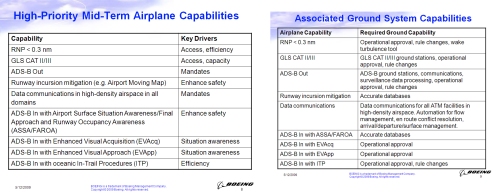Last week’s ATCA technical symposium in Atlantic City drew a large and interested crowd, and Fly NextGen was along for the ride. The event covered a lot of ground — so much so, it’s hard to know where to begin. (A PDF version of the agenda is here.)
We’ll explore a few different topics over a series of posts, but one presentation that stood out was that of Dr. Aslaug Haraldsdottir, who is a technical fellow with the Boeing ATM avionics team. Several of the graphics from Dr. Haraldsdottir’s presentation are worth sharing — first, here’s a look at how Boeing sees the market for highly equipped aircraft growing in the next 15 years (click to enlarge):
The jump from 19,000 to 36,000 is quite remarkable — of course, Boeing isn’t saying how many seats (or how much gross weight) are distributed among those aircraft.
Also, Dr. Haraldsdottir laid out Boeing’s priority list of aircraft capabilities, correlated to key market drivers and the necessary buildout on the ground to achieve each functionality (click to enlarge):
We feel that Boeing is to be commended for its transparency and leadership role on these topics. While it takes guts to divulge what some might consider to be strategic information and insights, there is an strong need for clear signs from the top industry players right now.
The more people open their hand and put their cards on the table, the more confidence will be generated among policymakers and large customers — and we believe that this, in turn, can help accelerate the equipage timeline.





You must be logged in to post a comment.